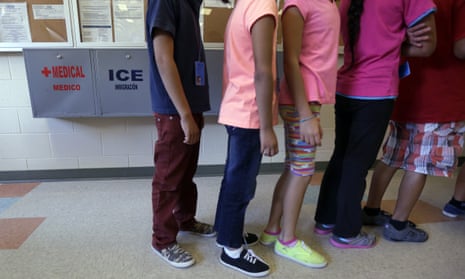On a desolate dirt road about an hour south of San Antonio, some 2,500 women and children will experience the Fourth of July in America for the first time this weekend. For them, there will be no celebration: no barbecue in the backyard or fireworks in the night sky. We proclaim to the world that those facing credible harm in their homelands can find refuge in America, and they followed our promise of sanctuary for hundreds of miles to reach our southern border. They risked life and limb to escape poverty, violence and sexual predators in their native lands to find safety in America.
And then we threw them in jail.
The South Texas Family Residential Center in Dilley, Texas – known simply as Dilley – is one of two detention facilities outside of San Antonio that I toured on a Congressional delegation last week. I went to see for myself the conditions that the women and children incarcerated there face firsthand – and what I saw was nothing short of heartbreaking.
Bungalows house multiple families per room with a communal shower and no privacy. Lack of medical and dental care is readily apparent – one girl I met on the trip had no teeth; another had a common and treatable infection and had not received help. Young children are denied consistent access to toys and the library. Some kids as old as seven or eight actually regressed back to wearing diapers as a result of their captivity.
While my colleagues and I were there, the women at Dilley began protesting their detainment. Bedsheets became banners calling for freedom. Children wore pillowcases with pleas for help scrawled on them. In the courtyard, they chanted “¡Queremos libertad!” – we want freedom!
Immigration and Customs Enforcement (ICE) pays $325.69 per day per detainee to the Corrections Corporation of America, a for-profit prison enterprise that claims on its website to be “proud to have this opportunity to serve our nation and aid those entrusted to our care.”
But over the past 11 years, 32 people have died in the “care” of Corrections Corporation of America’s facilities. Seven were suicides, and the rest resulted from a lack of medical attention. The unnecessary human suffering at the hands of our government – and for the profit of the private prison industry – is appalling and unjustifiable.
Is this really how we should treat asylum seekers? Is this what we meant when we emblazoned on the Statue of Liberty that iconic call for the tired, poor and huddled masses yearning to breathe free?
This is not an immigration issue; these people are not trying to cross our borders undetected. They are not here in search of of new economic opportunities. They are here tofind refuge from horrifying conditions. They seek out Border Patrol agents – walk right up to them – and ask for our help. Our laws are clear in this matter: credible concerns of harm merits hearings before an immigration judge. Until that legally-required hearing, asylum seekers are allowed to live in the United States on their own; we’re not supposed to be holding them in prison facilities at all.
To fix this, we must remove profit motives from incarceration in our society. To Corrections Corporation of America, these aren’t asylum seekers – they’re literally the company’s bottom line. What motive does the company have to do anything other than lock up as many as possible, for as long as they can? What motive do they have to provide anything other than the bare minimum when it comes to food, clothing, medical and dental needs, education and amenities? Every dollar they spend on their detainees is a dollar less for their profit margins.
Equally important, the Department of Homeland Security – and ICE under its purview – must stop acting lawlessly towards asylum seekers. We have a process in place to protect these people, and DHS has no excuse in disregarding it. Just this week, the Department of Homeland Security Advisory Council, an independent group that reports to DHS Secretary Jeh Johnson, released a scathing 29-page report outlining how DHS needs to clean its own house to stem abuse, corruption and use of force from its own ranks and operation.
After our site visit, DHS did take some initiative to soften the situation detainees face. But it does not matter how gilded a cage might be, it’s still a cage – it’s still a prison for innocent women and children. No amount of window dressing can fix this reality.
We all love celebrating the promise of American freedom and sanctuary on the Fourth of July, and the values we espouse provide all the guidance we need to right this situation: we are a nation that, above all else, protects freedom and individual liberty; we oppose human suffering and work to end it all over the world. Yet somehow, we’ve lost sight of the suffering we’re causing right here in our own backyard. The existence of the South Texas Family Residential Center, and the hundreds of facilities like it that quietly detain thousands of innocent people across our country, call into question whether or not we live up to our ideals.
As I prepared to leave Dilley, a boy no older than five came up and hugged my leg. He clung on for a moment, looked up at me, and asked, “Are you here to get us out of jail?”
Our government needs to ensure that this unjust incarceration does not happen to another five-year-old child, and it needs to abide by the high standards that the American people expect from it. It’s time to close these prisons and bring humanity into the lives of the women and children who came to America to seek more of it then they’d been offered at home.
